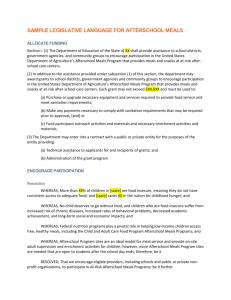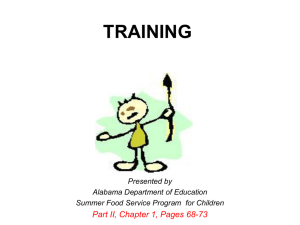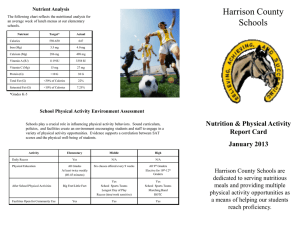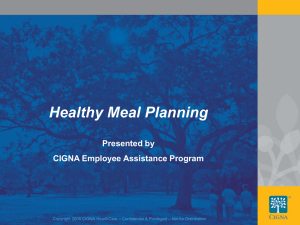here - National League of Cities
advertisement
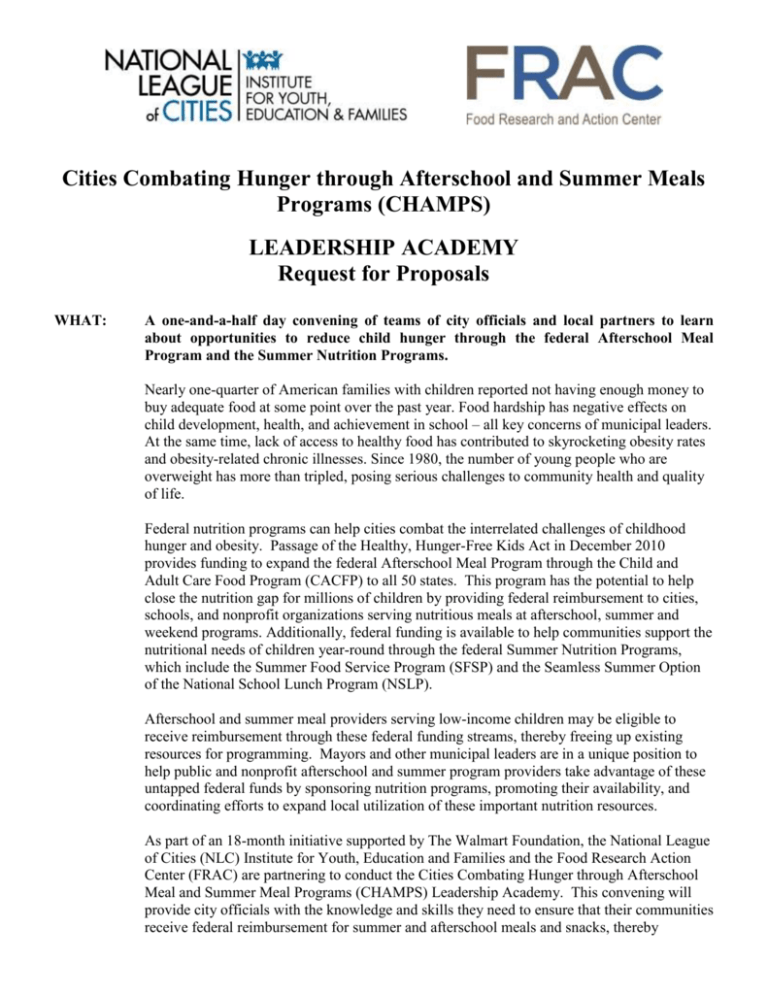
Cities Combating Hunger through Afterschool and Summer Meals Programs (CHAMPS) LEADERSHIP ACADEMY Request for Proposals WHAT: A one-and-a-half day convening of teams of city officials and local partners to learn about opportunities to reduce child hunger through the federal Afterschool Meal Program and the Summer Nutrition Programs. Nearly one-quarter of American families with children reported not having enough money to buy adequate food at some point over the past year. Food hardship has negative effects on child development, health, and achievement in school – all key concerns of municipal leaders. At the same time, lack of access to healthy food has contributed to skyrocketing obesity rates and obesity-related chronic illnesses. Since 1980, the number of young people who are overweight has more than tripled, posing serious challenges to community health and quality of life. Federal nutrition programs can help cities combat the interrelated challenges of childhood hunger and obesity. Passage of the Healthy, Hunger-Free Kids Act in December 2010 provides funding to expand the federal Afterschool Meal Program through the Child and Adult Care Food Program (CACFP) to all 50 states. This program has the potential to help close the nutrition gap for millions of children by providing federal reimbursement to cities, schools, and nonprofit organizations serving nutritious meals at afterschool, summer and weekend programs. Additionally, federal funding is available to help communities support the nutritional needs of children year-round through the federal Summer Nutrition Programs, which include the Summer Food Service Program (SFSP) and the Seamless Summer Option of the National School Lunch Program (NSLP). Afterschool and summer meal providers serving low-income children may be eligible to receive reimbursement through these federal funding streams, thereby freeing up existing resources for programming. Mayors and other municipal leaders are in a unique position to help public and nonprofit afterschool and summer program providers take advantage of these untapped federal funds by sponsoring nutrition programs, promoting their availability, and coordinating efforts to expand local utilization of these important nutrition resources. As part of an 18-month initiative supported by The Walmart Foundation, the National League of Cities (NLC) Institute for Youth, Education and Families and the Food Research Action Center (FRAC) are partnering to conduct the Cities Combating Hunger through Afterschool Meal and Summer Meal Programs (CHAMPS) Leadership Academy. This convening will provide city officials with the knowledge and skills they need to ensure that their communities receive federal reimbursement for summer and afterschool meals and snacks, thereby assisting low-income children and their families while also bringing much-needed federal dollars into their local economies. For more information about these programs, see the fact sheets below or visit the FRAC website at http://frac.org/federal-foodnutrition-programs/afterschool-programs/ and http://frac.org/federal-foodnutrition-programs/summer-programs/. WHERE: Denver (May 22-23, 2013) OR Washington, D.C. (June 4-5, 2013)* The leadership academies will be offered in two locations. The first convening in Denver is intended for cities in the western half of the U.S., and the Washington, D.C., convening for cities in the eastern half. Depending on the number of applications we receive for each location, city officials may be asked to attend an academy that is not in their region. WHO: Local elected officials, senior city staff, local anti-hunger groups, and other stakeholders applying in three-person city teams. Up to 20 cities will be selected to attend one of two leadership academies (10 cities for each). Each city will bring a team of three representatives that must include at least one city government representative (a local elected official and/or city staff person who will be directly involved in local implementation). If there is an anti-hunger organization that is part of FRAC’s national network and is located in the applying city’s state (see the list of organizations here: http://frac.org/state-news/state-anti-hunger-organizations/), we highly encourage partnerships with the organization and inclusion of one of their representatives as part of the city team. Other stakeholders can include but are not limited to representatives of school districts, afterschool and summer programs or intermediaries, and community-based organizations. NLC and FRAC will, on a competitive basis, select a diverse set of cities of various sizes from different regions of the country. Preference will be given to cities that are members of NLC. Selection criteria will focus on how the leadership academy can bolster local efforts to expand participation in afterschool and summer meal programs and to overcome identified challenges. Successful applications will demonstrate high-level municipal leadership for increasing the number of children receiving nutritious meals after school and during the summer months and a commitment to collaboration among city, school and community agencies on citywide implementation of the Afterschool Meal Program and the Summer Nutrition Programs. The focus of the leadership academies and the larger project will be to connect both federal programs within communities so that children have access to nutritious meals year-round. Cities that have existing summer meal programs are eligible to apply. WHEN: The leadership academies will take place on May 22-23, 2013 (Denver), and on June 4-5, 2013 (Washington, D.C.). Applications for both convenings must be received by NLC on or before March 25, 2013. Early applications are encouraged. All selections will be announced by April 22, 2013. BENEFITS: Selected city teams will learn about the requirements for receiving federal dollars to implement the Afterschool Meal Program and the Summer Nutrition Programs in their cities; discuss and review new ideas, strategies, and best practices for increasing utilization of these * The location of the eastern regional leadership academy is still being finalized. If the convening is not held in Washington, D.C., it may instead be held in Philadelphia. programs; gain access to and guidance from afterschool and summer nutrition program experts; and strengthen their relationships with peers in cities across the nation. Additionally, NLC will be offering grants of $30,000 to $60,000 to as many as 15 cities out of the 20 cities competitively selected to participate in the upcoming leadership academies. NLC currently plans to invite ONLY those cities represented at the leadership academies to apply for these grants, which are intended to help launch and expand afterschool and summer meal programs in their communities. Grant applications will be made available for participants and reviewed in detail at the leadership academies. TRAVEL: NLC will cover the travel costs (air transportation, meeting hotel, and other travel-related costs) for each city team of up to three participants according to NLC’s travel reimbursement policy. The team must include at least one city government representative. Meeting participants will be reimbursed promptly upon submission of travel receipts following the convening. An informational webinar for leadership academy applicants will be held Friday, March 8, at 1:00 p.m. Eastern Time. To register, visit http://www.nlc.org/build-skills-and-networks/education-and-training/eventcalendar/cities-combating-hunger-through-afterschool-and-summer-meal-programs-%28champs%29-2013applicant-webinar. APPLICATION FORM – SUBMISSION DEADLINE: MARCH 25, 2013 CITIES COMBATING HUNGER THROUGH AFTERSCHOOL AND SUMMER MEALS PROGRAMS (CHAMPS) Leadership Academy CITY TEAM APPLICATION Meeting Location preference (Please check one*): Washington, D.C. Denver, CO * Every effort will be made to accommodate your first preference Team Member One (City Representative Lead): Name:________________________________________________________________________ City: ___________________________________________________ Population: ___________ Title: _________________________________________________________________________ Office/Agency: _________________________________________________________________ Street Address: _________________________________________________________________ City, State, and Zip Code: ________________________________________________________ Phone: (_____)___________________________ Fax: (_____)___________________________ Email: ________________________________________________________________________ Team Member Two: Name:________________________________________________________________________ Organization/Agency:____________________________________________________________ Title:_________________________________________________________________________ Street Address:_________________________________________________________________ City, State, and Zip Code: ________________________________________________________ Phone: (_____)___________________________ Fax: (_____)___________________________ Email: ________________________________________________________________________ Team Member Three: Name:________________________________________________________________________ Organization/Agency:____________________________________________________________ Title:_________________________________________________________________________ Street Address:_________________________________________________________________ City, State, and Zip Code: ________________________________________________________ Phone: (_____)___________________________ Fax: (_____)___________________________ Email: ________________________________________________________________________ TEAM APPLICATION QUESTIONS Please complete the form above. Responses to the questions below will help us gauge your community’s capacity for expanding participation in the CACFP Afterschool and the Summer Nutrition Programs. Only one application is required per city. Please do not exceed 2-3 pages for the narrative portion. 1. Describe the current state of afterschool and/or summer programming for children in your community. 2. How have your mayor and/or other municipal leaders in your city made combating childhood hunger a priority? To what extent would city leaders or other government representatives be involved in your implementation of the afterschool and summer nutrition programs? 3. Are there existing afterschool and/or summer nutrition programs operating in your city? If so, what are the sponsoring agencies and what is the city government’s role in these programs? Please describe any existing or potential future collaboration among city agencies, schools, antihunger groups, or community-based organizations to improve or expand these child nutrition programs. 4. At what percentage of your city’s public schools are 50 percent or more students eligible to receive free and reduced-price school meals and which areas would you target for the implementation of the summer and afterschool nutrition programs†? 5. Describe how attending this leadership academy will strengthen local efforts to implement or expand the Afterschool Meal Program and the Summer Nutrition Programs in your city. Please identify one or two specific goals that you would like to accomplish, how many children you hope to serve with this program, the desired increase in the number of participating afterschool and summer programming sites, and specific strategies you would like the leadership academy to address. Application Admissions Checklist: Typed application form Responses to the required questions (no more than three pages) Email application materials to Imani Hope by March 25, 2013: ihope@nlc.org For questions about the application materials or the leadership academies, please contact Imani Hope at the above email address or at (202) 626-3180. † Eligibility for the CACFP Afterschool Meal Program and the Summer Food Service Program (SFSP) is based on the free and reduced-price meal percentages of area schools. Afterschool and summer meal site locations, with some exceptions in the summer programs, must be located in an area where 50 percent or more students at the nearby elementary, middle, or high school are eligible for free or reduced-price school meals. For more information, please see the fact sheets below or www.frac.org or contact Kate Sims at FRAC at ksims@frac.org or (202) 986-2200, x3023. Fact Sheet: The Afterschool Meal Program Program Overview The Afterschool Meal Program offered through the Child and Adult Care Food Program (CACFP) provides federal funding to afterschool programs operating in a low-income area to serve meals and snacks to children 18 and under after school, on weekends, and during school holidays. Extendedday schools that run for an additional hour or more also may be eligible. Youth who turn 19 during the school year remain eligible until the end of the school year. Local government agencies, school districts and private nonprofit organizations can sponsor afterschool meal sites, which may be located at schools, recreation centers, YMCAs, Boys and Girls Clubs, and other locations where afterschool programs are offered to children. In order to participate, an afterschool program must operate in a low-income area where 50 percent of the children in the local elementary, middle or high school qualify for free or reduced price meals; offer educational or enrichment activities; and meet state and local health and safety standards or when required, be licensed for child care. Children receiving meals and snacks from participating afterschool programs can be either drop-in or enrolled. Meal counts and corresponding attendance records must be maintained for each day of operation in order to be reimbursed for all meals and snacks served. Reimbursable meals and snacks must meet federal nutrition standards. The meal can be served at any point during the afterschool program. Even though the meal is often referred to as supper, programs that operate on weekends and school holidays can chose to serve breakfast or lunch instead. Programs can receive funding for a maximum of one meal and one snack per day. CACFP Plays an Important Role in Communities When the school bell rings, millions of low-income children do not know where their next meal will come from. The breakfast and lunch they receive during the school day may be their only access to nutritious meals until the following day, after the weekend, or after a school holiday break. CACFP fills this gap by providing free meals and snacks to children who might otherwise go hungry. The Afterschool Meal Program is an exciting new opportunity to financially support local after school programs and attract more students to activities that help them learn and stay safe when school is out. Afterschool Meals Benefit Low-Income Children and Families CACFP contributes to the healthy growth and development of low-income children by providing them with nutritious snacks and meals when school is out so they are better able to learn during the school day. Afterschool meal programs are required to offer educational or enrichment activities in addition to meals, which enables children to learn and stay safe when school is out. The meals served through CACFP draw children to these activities. Afterschool meals help parents stretch their food dollars at home during the school year. It Pays to Serve Afterschool Meals Participating afterschool programs are reimbursed for each meal they serve, which means the funding increases as the program grows. For the 2012-2013 school year, CACFP sponsors receive $1.55 for each breakfast served, $2.86 per lunch or dinner served, and $0.78 per snack. CACFP sponsors can additionally choose to receive the value of commodities (or cash in lieu of commodities), $0.2275 for July 2012 through June 2013, for each lunch and dinner served, which would total about $3.08 per lunch or dinner served. Afterschool nutrition funding can add up. For example, an afterschool program serving a meal to 50 children 180 school days a year would receive approximately $25,740 in federal funding through the CACFP without the value of commodities and approximately $27,720 with the value of commodities. Serving a snack in addition to the meal would generate an additional $7,020 per year, which would total $32,760 without the value of commodities and $34,740 with the value of commodities. Programs that currently provide meals and snacks but have not received federal funding through CACFP can be reimbursed and use the money previously spent on food to serve additional children, offer more activities or hire additional staff. USDA Guidance Makes the Program Easier to Operate States can create a simplified School Food Authority (SFA) application process for school districts that already participate in the School Breakfast Program or the National School Lunch Program. Additionally, schools and sponsors whose meals are prepared by a school nutrition department can use “OVS” in the Afterschool Meal Program. OVS allows schools and sponsors receiving their meals from schools to offer all of the meal components, but students do not have to take all of the items. This can lower plate waste and food costs. OVS cannot be used for snacks. States can tailor their CACFP application and training specifically to the Afterschool Meal Program. Participating afterschool programs have some options to reduce paperwork, including not requiring a management plan if it is a single site program; tailoring the budgetary level of detail to the size and scope of the applicant; and not requiring production records. Get Started Afterschool meals provide nutritious food to hungry children when the school bell rings. To get started, contact the state child nutrition agency at http://www.fns.usda.gov/cnd/Contacts/StateDirectory.htm . The state agency can provide potential sponsors with more information about the program, an application and inform them when the next CACFP Afterschool Meal Program training takes place. Fact Sheet: The Summer Food Service Program Program Overview The Summer Food Service Program (SFSP) provides free meals and snacks to low-income children 18 and under when school is not in session. Local governments, school districts and nonprofits can sponsor summer food sites, which may be located at schools, parks, recreation centers, housing projects, migrant centers, Indian reservations, YMCAs, Boys and Girls Clubs, houses of worship, summer camps, and others places where children congregate when school is out. A site qualifies either as an open or an enrolled site. An open site is located in a low-income area where 50 percent or more of the children are eligible for free or reduced-price school meals. The site is then open to all the children in the community (open restricted sites are open sites that limit or restrict participation for reasons of safety, security, or control). An enrolled site only provides meals to children enrolled in the program. An enrolled site qualifies if it is located in a low-income area or if at least half of the children enrolled in the program are eligible for free or reduced-price school meals. Reimbursable meals must meet federal nutrition standards. SFSP Plays an Important Role in Communities When school lets out, millions of low-income children lose access to school breakfast, lunch and afterschool meals that are available during the regular school year. SFSP fills this gap by providing free meals and snacks to children who might otherwise go hungry. Currently, the program is underutilized. Nationally, only 1 out of 7 children who receive free or reduced-price meals during the school year continue to receive meals during the summer months. Summer Meals Benefit Low-Income Children and Families SFSP contributes to the healthy growth and development of low-income children by providing them with nutritious snacks and meals when school is out so they are better able to learn when they return to school. Many SFSP sites provide educational enrichment and recreational activities in addition to meals, which enables children to learn and stay safe when school is out. The meals served through SFSP draw children to these activities. Summer meals help parents stretch their food dollars at home during the summer months. It Pays to Serve Summer Meals The SFSP reimbursements provide essential financial support to programs that serve low-income children when school is not in session. For the summer 2013, SFSP sponsors will receive $1.94 for each breakfast served, $3.41 per lunch or supper, and $0.80 per snack. Sponsors located in rural areas or those that prepare their own meals on-site receive a higher reimbursement - $1.98 per breakfast, $3.47 per lunch or supper, and $0.82 per snack. Lunch and supper cannot be reimbursed for the same day by the same site, except for camp and migrant sites. Summer nutrition funding can add up. For example, a summer program serving breakfast and lunch to 50 children for eight weeks would receive approximately $10,700 in federal funding through the SFSP or $10,900 if located in a rural area or self-prep. Programs that provide meals but have not received federal funding through SFSP can be reimbursed and use the money previously spent on food to serve additional children, offer more activities or hire additional staff. USDA Guidance Makes the Program Easier to Operate States can create a simplified SFSP application process for afterschool programs that already participate in the CACFP Afterschool Meal Program and for School Food Authorities that already participate in the School Breakfast Program or the National School Lunch Program. Sponsors sign a permanent agreement with the state SFSP agency. Private nonprofit sponsors can operate under the same rules as all other sponsors – there is no longer a cap on the number of sites or children served. Sponsors are no longer required to keep records and accounts separately for administrative and operating costs. Instead, sponsors simply follow a “meals times rates” formula that allows them to claim the maximum reimbursement. This change in accounting procedures dramatically reduces the paperwork involved in operating SFSP. Get Started Summer meals provide nutritious food to hungry children when school is out. To get started, contact the state child nutrition agency at http://www.fns.usda.gov/cnd/Contacts/StateDirectory.htm. The state agency can provide potential sponsors with more information about the program, an application and inform them when the next SFSP training takes place. Program Comparison Chart: Summer Nutrition Programs & the Afterschool Meal Program Topic Sponsor Eligibility Site Eligibility Participant Eligibility Meal Service Reimbursement Rates Summer Food Service Program (SFSP) Any public school, nonprofit private school, local government agency, or private nonprofit organization. A site qualifies either as an open or an enrolled site. An open site is located in a lowincome area where 50 percent or more of the children are eligible for free or reduced-price school meals according to elementary, middle, or high school data or census data. An enrolled site qualifies if it is located in a low-income area or if at least half of the children enrolled in the program are eligible for free or reduced-price school meals. Children 18 years or younger and persons 19 or older with a physical disability, as defined by the State. Open sites are open to all children in the community (open restricted sites limit or restrict participation for reasons of safety, security or control). An enrolled site only provides meals to children enrolled in the program. During the summer months or during student vacations for year round schools. Maximum two meals per day, except 3 meals per day for migrant sites and camps (only reimbursed for children who are eligible for free or reduced-price school meals). SFSP 2013: $1.94 per breakfast, $3.41 per lunch or supper, and $0.80 per snack. Rural and self-prep sites receive $1.98 per breakfast, $3.47 per lunch or supper, and $0.82 per snack. Lunch and supper cannot be reimbursed for the same day Seamless Summer Option of the National School Lunch Program (NSLP) Afterschool Meal Program through the Child and Adult Care Food Program (CACFP) School Food Authorities (SFAs) Same as SFSP, in addition to some for-profit entities. Same as SFSP. A site qualifies if it is in a lowincome area where 50 percent of the children in the local elementary, middle or high school are qualified for free or reduced price meals. Same as SFSP. Children 18 years or younger. Youth who turn 19 during the school year remain eligible until the end of the school year. Children may be either drop-in or enrolled. Attendance records required. Same as SFSP During the school year after school, on weekends, and during school holidays. Meals can be served at any point during program. Maximum one meal and one snack per day. NSLP SY 2012-2013 “free” rates: $1.85 per breakfast, $2.88 per lunch or supper (plus an additional $0.2275 in commodities), and $0.78 per snack. Schools that qualify for additional “severe need” breakfast reimbursement or the $0.02 differential for CACFP SY 2012-2013 “free” rates: $1.55 per breakfast, $2.86 per lunch or supper (plus an additional $0.2275 in commodities or cash in lieu of commodities), $0.78 per snack. by the same site, except for camp and migrant sites. Meal Pattern Programmatic Requirements Breakfast: 1 serving of milk, 1 serving of fruit or vegetable, 1 serving of grains/bread; Lunch/Supper: 1 serving of milk, 2 servings of fruits and/or vegetables, 1 serving of grains/bread, 1 serving of meat or meat alternate; Snack: (must include two of the following) 1 serving of milk, 1 serving of fruit and/or vegetable, 1 serving of grains/bread, 1 serving of meat/meat alternate. SFAs may substitute School Breakfast Program (SBP)/NSLP meal patterns. No requirement. lunch during the school year will continue to receive it during the summer. Lunch and supper cannot be reimbursed for the same day by the same site, except for camp and migrant sites. SBP/NSLP meal patterns Same as SFSP. Same as SFSP. SFAs may substitute SBP/NSLP meal patterns. Must offer educational or enrichment activities.
